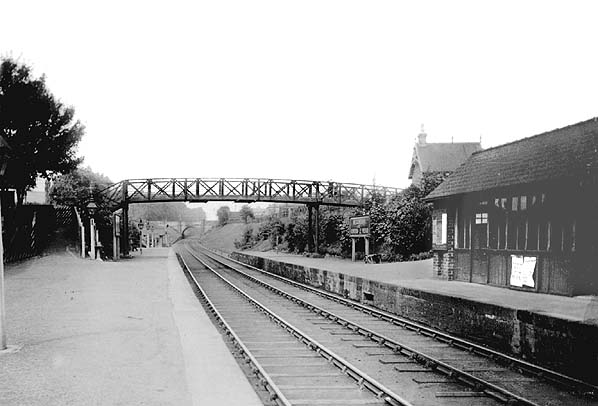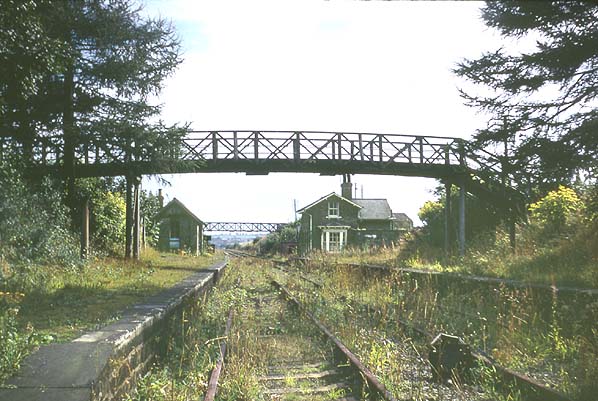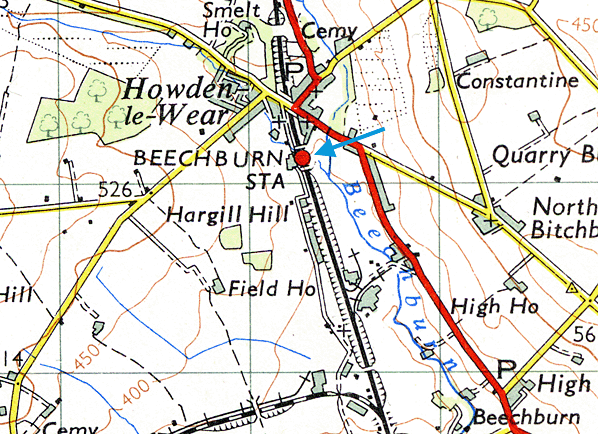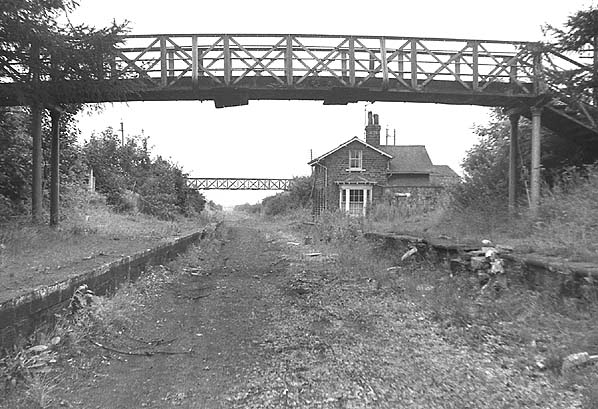|
Notes: Beechburn's history cannot be separated from that
of Howden with any certainty. The earliest record of a station
at Howden is a Stockton & Darlington Railway minute of
14 February 1845, when it seems to have been regarded as a
station, but without facilities; it appeared in the company
timetable for September 1847 but not in Bradshaw and was closed
by 20 December 1847 when plans for converting the waiting-room
into a house were agreed.
 There is record of a station at Beechburn in May 1948 with
no mention of Howden and S & D minutes show that cabin
from Shildon was ordered to be moved to Beechburn to serve
as a waiting-room and that station was still incomplete in
January 1849, but a station incomplete a year or two after
opening was not unusual on the S&D. There is record of a station at Beechburn in May 1948 with
no mention of Howden and S & D minutes show that cabin
from Shildon was ordered to be moved to Beechburn to serve
as a waiting-room and that station was still incomplete in
January 1849, but a station incomplete a year or two after
opening was not unusual on the S&D.
On 14 August 1855 improvements to Howden station were authorised,
suggesting it had re-opened, but S&D use of names was
so casual that they might have meant Beechburn.
Minutes of 25 November 1868 show the agreed reopening of
Howden with no reopening date found. Beechburn's service became
two way April or May 1869. Howden was renamed Beechburn on
16 April 1869.
 Early OS maps show two stations in the area, one just north
of Howden at Beechburn Colliery, the other just south. Bartholomew's
1860's Imperial Atlas names the northern one Beechburn Colliery
and the southern one North Beechburn, probably not official
names. Early OS maps show two stations in the area, one just north
of Howden at Beechburn Colliery, the other just south. Bartholomew's
1860's Imperial Atlas names the northern one Beechburn Colliery
and the southern one North Beechburn, probably not official
names.
The likeliest explanation is that the original stop was the
southern one, Howden; replaced by northern, Beechburn, late
1847. In 1869 Howden was reopened and renamed Beechburn.
BRIEF HISTORY OF THE BISHOP
AUCKLAND TO BLACKHILL LINE
The western section of the Stockton and Darlington Railway
had been progressively improved and extended with the Bishop
Auckland & Weardale Railway finally reaching Crook in
1843.
The B A & W company minutes show that the line opened
to a permanent station at Bishop Auckland on 30 January 1843,
ahead of the rest of the line to Crook and that the generally
quoted 8 November 1843 for opening to Crook was for goods
only. The line was leased by the Stockton & Darlington
Railway.
 The passenger opening date to Crook has not so far been traced;
however, the minutes do show that the line was inspected on
1 January 1844 and that permission to open for passengers
was received by on or before 6 January. The following stations
were proposed: South Church, Bishop Auckland, Escombe, Old
Etherley Colliery, Low Bitchburn, Howden and Crook, only South
Church, Bishop Auckland and Crook had been completed but the
line was authorised for opening on 3rd January 1844. Escombe
and Low Bitchburn stations are never mentioned again and were
probably never built. The passenger opening date to Crook has not so far been traced;
however, the minutes do show that the line was inspected on
1 January 1844 and that permission to open for passengers
was received by on or before 6 January. The following stations
were proposed: South Church, Bishop Auckland, Escombe, Old
Etherley Colliery, Low Bitchburn, Howden and Crook, only South
Church, Bishop Auckland and Crook had been completed but the
line was authorised for opening on 3rd January 1844. Escombe
and Low Bitchburn stations are never mentioned again and were
probably never built.
It is likely that the initial service to Crook was market
days only because when it first appeared in Bradshaw in July
1844, only a Thursday market service was shown but the line
was in full use by January 1845.
S & D records show an experimental extension north from
Crook to Crawley (later renamed Park Head) and Cold Rowley
(later renamed Rowley), dividing at Waskerley which opened
on 1 September 1845 although Bradshaw shows Crook as the terminus
until November 1846.
 By March 1850 there was a full service from Crook to Cold
Rowley with stops at Tow Law and Waskerley Park. Tow Law first
appears in timetables in September 1847; references have been
found to additional stops at High Souk (alias High Stoop),
which appears on the early Ordnance Survey maps and to Saltersgate
Cottage, which would have been further north towards Burnhill,
but passenger use cannot be confirmed. A station at Burnhill
(originally Burnhill Junction) opened on 4th July 1859. By March 1850 there was a full service from Crook to Cold
Rowley with stops at Tow Law and Waskerley Park. Tow Law first
appears in timetables in September 1847; references have been
found to additional stops at High Souk (alias High Stoop),
which appears on the early Ordnance Survey maps and to Saltersgate
Cottage, which would have been further north towards Burnhill,
but passenger use cannot be confirmed. A station at Burnhill
(originally Burnhill Junction) opened on 4th July 1859.
The Bishop Auckland & Weardale Railway amalgamated with
the Wear Valley Railway in 1847 which was in turn taken over
by the Stockton & Darlington in 1858 and by the North
Eastern Railway in 1863.
 The Crawley (Park Head) service was an early casualty, losing
its passenger service on 1st April 1846 although it has been
suggested that there was some later passenger use until October
1862 while the goods service was retained until 2nd August
1865. The Crawley (Park Head) service was an early casualty, losing
its passenger service on 1st April 1846 although it has been
suggested that there was some later passenger use until October
1862 while the goods service was retained until 2nd August
1865.
In NER days a through service was provided from Darlington
to Tyneside via Bishop Auckland, Crook, Tow Law, Burnhill
and along the Derwent Valley Line through Blackhill &
Swalwell. With increasing competition from roads and the decline
in the handling of lime and stone the line north of Tow Law
to Blackhill (Consett) was closed to passengers in May 1939
along with the stations at Burnhill and Rowley ending through
running to Tyneside. Shortly after closure the Government
built the Salters Gate Ammunition Depot across the line between
Salters Gate and Burnhill which effectively totally closed
the through line although munitions trains could access the
Burnhill Station transfer yard from both directions.
 The line was further cut back to Crook on 11th June 1956
and the final section of line from Bishop Auckland - Crook
closed to passengers on 8th March 1965. The track north of
Wear Valley Junction was lifted in late 1967 or early 1968. The line was further cut back to Crook on 11th June 1956
and the final section of line from Bishop Auckland - Crook
closed to passengers on 8th March 1965. The track north of
Wear Valley Junction was lifted in late 1967 or early 1968.
The line between Bishop Auckland and Crook served a number
of collieries and other industrial sites. Click here
for a full list. Tickets from Michael Stewart.
To see the
other stations on the Bishop Auckland - Rowley line click
on the station name: Bishop
Auckland, Etherley,
Wear Valley
Junction, Crook,
Tow Law, High
Souk, Saltersgate
Cottage, Burnhill Junction
(Military Exchange Station), Burnhill
& Rowley
See also stations
on the Wear Valley line to Wearhead
|

 Beechburn Station
looking north c. 1905
Beechburn Station
looking north c. 1905
 Beechburn Station
looking north in the 1920's or 1930's
Beechburn Station
looking north in the 1920's or 1930'sold1a.jpg) Beechburn
Station looking south in 1965
Beechburn
Station looking south in 1965old6.jpg) Beechburn Station looking north c1967.
Beechburn Station looking north c1967.
 Home
Page
Home
Page
 There is record of a station at Beechburn in May 1948 with
no mention of Howden and S & D minutes show that cabin
from Shildon was ordered to be moved to Beechburn to serve
as a waiting-room and that station was still incomplete in
January 1849, but a station incomplete a year or two after
opening was not unusual on the S&D.
There is record of a station at Beechburn in May 1948 with
no mention of Howden and S & D minutes show that cabin
from Shildon was ordered to be moved to Beechburn to serve
as a waiting-room and that station was still incomplete in
January 1849, but a station incomplete a year or two after
opening was not unusual on the S&D. Early OS maps show two stations in the area, one just north
of Howden at Beechburn Colliery, the other just south. Bartholomew's
1860's Imperial Atlas names the northern one Beechburn Colliery
and the southern one North Beechburn, probably not official
names.
Early OS maps show two stations in the area, one just north
of Howden at Beechburn Colliery, the other just south. Bartholomew's
1860's Imperial Atlas names the northern one Beechburn Colliery
and the southern one North Beechburn, probably not official
names.  The passenger opening date to Crook has not so far been traced;
however, the minutes do show that the line was inspected on
1 January 1844 and that permission to open for passengers
was received by on or before 6 January. The following stations
were proposed: South Church, Bishop Auckland, Escombe, Old
Etherley Colliery, Low Bitchburn, Howden and Crook, only South
Church, Bishop Auckland and Crook had been completed but the
line was authorised for opening on 3rd January 1844. Escombe
and Low Bitchburn stations are never mentioned again and were
probably never built.
The passenger opening date to Crook has not so far been traced;
however, the minutes do show that the line was inspected on
1 January 1844 and that permission to open for passengers
was received by on or before 6 January. The following stations
were proposed: South Church, Bishop Auckland, Escombe, Old
Etherley Colliery, Low Bitchburn, Howden and Crook, only South
Church, Bishop Auckland and Crook had been completed but the
line was authorised for opening on 3rd January 1844. Escombe
and Low Bitchburn stations are never mentioned again and were
probably never built. By March 1850 there was a full service from Crook to Cold
Rowley with stops at Tow Law and Waskerley Park. Tow Law first
appears in timetables in September 1847; references have been
found to additional stops at High Souk (alias High Stoop),
which appears on the early Ordnance Survey maps and to Saltersgate
Cottage, which would have been further north towards Burnhill,
but passenger use cannot be confirmed. A station at Burnhill
(originally Burnhill Junction) opened on 4th July 1859.
By March 1850 there was a full service from Crook to Cold
Rowley with stops at Tow Law and Waskerley Park. Tow Law first
appears in timetables in September 1847; references have been
found to additional stops at High Souk (alias High Stoop),
which appears on the early Ordnance Survey maps and to Saltersgate
Cottage, which would have been further north towards Burnhill,
but passenger use cannot be confirmed. A station at Burnhill
(originally Burnhill Junction) opened on 4th July 1859. The Crawley (Park Head) service was an early casualty, losing
its passenger service on 1st April 1846 although it has been
suggested that there was some later passenger use until October
1862 while the goods service was retained until 2nd August
1865.
The Crawley (Park Head) service was an early casualty, losing
its passenger service on 1st April 1846 although it has been
suggested that there was some later passenger use until October
1862 while the goods service was retained until 2nd August
1865. The line was further cut back to Crook on 11th June 1956
and the final section of line from Bishop Auckland - Crook
closed to passengers on 8th March 1965. The track north of
Wear Valley Junction was lifted in late 1967 or early 1968.
The line was further cut back to Crook on 11th June 1956
and the final section of line from Bishop Auckland - Crook
closed to passengers on 8th March 1965. The track north of
Wear Valley Junction was lifted in late 1967 or early 1968.

 The
site of Beechburn Station looking north in April 2006; taken from
the same viewpoint
The
site of Beechburn Station looking north in April 2006; taken from
the same viewpoint